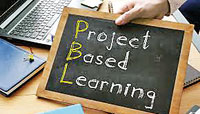Creating Educational Brands in line with PBL and STEAM
View(s):There is no doubt that the Internet and technology in communication make a considerable shift in the way education is going to be delivered in the future. Education today is delivered as a service by the service providers or the educational institutes/brands and is received by the students. Any service delivered in the world consists of two main elements; that is the role of performing a task and the empathy demonstrated towards those who receive the service. In the ancient historic times in Eastern education, the emphasis was placed more on the empathy aspect of education where the guru or the teacher was able to read the minds of his students to gauge his/her level of comprehension abilities and wisdom. Therefore, the role of the guru or the teacher mainly focuses on guiding the students through a process where they learn how to make meanings out of what they experience in the learning process by mostly observing what they see. The time it takes for a student to learn was never a problem for the teacher or the guru. The relationship between the guru and the golaya (Student) was a strong bond as the guru knew how to shape the thinking of his student.
With the rapid expansion of industries at the beginning of the 20th century, mostly with the spread of industrialization, the Western world wanted more skilled workers to perform different types of work in different disciplines. During the post-World War – ii era, with the invention of technological advancements, and also management disciplines such as human resource management, corporate management, etc, the need to have more qualified people was felt more for the growth of profit-making organizations. The demand created through this advancement created a vacuum in the educational sector in producing more and more qualified people. Therefore, Western universities came up with robust educational programmes that are designed to have a batch of a particular number of students who would want to pursue a similar qualification or study. The job vacancies were to be filled with these students who would come out of a university in a given time frame to fill the demand in the job market. As a result of this, more and more educational entities came into the system. In this process, education got systemized and also got mechanised allowing institutions to produce more qualified people as quickly as possible. East also learned the same from the West and adopted it faster to suit the market needs. Today, the industry of education is full of fly-by-night institutions that offer many qualifications that are mostly classroom-based and do not have much of an involvement with the external environment. The process of immersing in learning is no longer the objective. On one hand, we can accuse the educational entities of ruining the process of education but on the other hand, with technological advancements, what is taught today expires in no time therefore, it doesn’t make sense for educational institutes to give in-depth knowledge of anything spending years and years. This has set a new trend to take a horizontal approach to education which in the past was more vertical where the student had the luxury of diving deep into one subject area.
What is PBL and STEAM
At the very beginning of it, it was all about S&T (Science and Technology), and later added E (Engineering) making it SET. Adding Mathematics to this equation, the same was then referred to as STEM. The same West that created the system of education more based on classrooms is now proposing to go back to a system where the student is immersed in the process of education making a shift from STEM-based education (Science, Technology, Engineering, Mathematics) to a more of a rich education which allows the student to focus on arts to make it STEAM.
STEAM is an educational approach to learning that uses science, technology, engineering, arts, and mathematics as access points for guiding students’ inquiry, dialog, and critical thinking. The difference is that arts are included, ranging from visual arts, language arts, and physical arts to music and more. STEAM focuses on sparking imagination and creativity through the arts in ways that naturally align with STEM learning.
Instead of classroom-based learning, now the focus is set more on project-based learning (PBL) where the student is confronted with a problem or a project to be resolved or implemented respectively. Project Based Learning is a teaching method in which students gain knowledge and skills by working for an extended period to investigate and respond to an authentic, engaging, and complex question, problem, or challenge. This is an important skill for success not only in school but also in the workplace. Additionally, project-based learning can help students develop creativity and innovation as they are encouraged to think outside of the box and come up with unique solutions to problems.
 Future of education
Future of education
Before talking about the future, it’s important to look at the present situation of our educational setup.
Some teachers who are trying to educate pupils in secondary and tertiary grades are miserably failing to perform as the internet has come to the forefront of education allowing pupils to search anything online to find solutions. They already have access to rich content and are fully equipped with the latest developments in any given area/s of study. This has challenged teachers today more than ever. Teachers not only lose credibility today but also the emotional touch they have with students. Though we are not seeing the social transformation that is taking place in the societal context, it is implicit to all of us that the social structure and the relationships are also challenged by technology and it’s already challenging the fundamentals of the social relationships. This has an impact on teachers too. Education has become more of a service provided by a teacher to a student. If the teacher is not ready to empathize with the student due to the knowledge gap, the student will end up empathizing with the teacher. In some of the leading Colombo schools this is already happening. The pupils in the secondary and tertiary grades play truant now as they simultaneously read for London exams while trying to sit for local Ordinary and Advanced level exams. In that sense, students have fast-forwarded their education in which the teacher’s role has become insignificant at times. Gone were the days when students worked hard to enter the university system. Now they have many opportunities in the system to educate themselves and get qualified. This started when university-selected students started following CIMA, CIM, and other professional exams while reading for their university degree. Over the last decade or so, the same has cascaded down to school kids who now are trying to multitask and gain more qualifications to stay ahead of the game.
In this backdrop, the future of education is more challenging to teachers than students. Adding to the same, the intervention of AI in education will play a significant role in shaping the future of education. The realm of understanding of pupils will be a function of their affordability in technology. The students who can invest well in AI equipment will stay ahead of the game invariably. Unless the government works on getting funds from donor countries and tries to set up AI-based educational systems in Sri Lanka, both the government and the educational systems will die a natural death. As we read this, the Ministry of Education tries to bring reforms to the current system to make it more resilient and to give the best to our students. The introduction of STEAM and PBL is a part of this mission. The efforts taken by the educationalists and the government are commendable in making a positive impact on the educational system. The resource limitation hampers the process however, the subject minister, secretary and their teams are trying to do their best.
The role of the private sector in education
In this backdrop, the role of private sector educational setup will have to play a crucial role in giving the best to those who can afford to get it. But the question remains then is who will take care of the rural sector? Those who can’t afford to get these facilities will lag. PBL or STEAM-based education will make sense if it’s backed with technology. Access to the internet and devices to surf the web will allow pupils to pursue their own education rather than, trying to educate them under a fixed syllabus, etc. Another important aspect to consider is the ability to provide a wide array of choices to students. Conventional Accounting, marketing, supply chain management, etc will not be in demand. Pupils would want to explore unconventional disciplines of psychology, leadership, entrepreneurship, medicine, AI-based manufacturing, AI-based marketing, etc. Also, another area to look at is the areas that are contributing to the national economy. Tourism, culinary arts, textile, and design-based qualifications, etc. should be offered if we are to develop our economy.
Conclusion
The private sector of Sri Lanka will play a crucial role in education whilst the free education system will prevail to serve the masses. In an economy where most facilities are privatised, if the government is expecting their public servants to do miracles in the education sector, it will not be realistic. Whether the government likes it or not, the parents are spending a colossal amount of money in private tuition. They send their children to school to get them a name to that education. But the real education takes place in private tuition. Private tuition masters are earning money as they get their students to get through exams. But what’s tested in the exam? It is mostly the memory of the students. Until the evaluation systems are changed in such a way real brainy ones are picked to give quality education, the students will inevitably go to private tuition. Therefore, there is an opportunity for someone to investigate these gaps and introduce a proper education system to Sri Lanka. In creating new education brands, STEAM and PBL should be at the forefront.
HitAd.lk is the best and biggest mobile phone market in Sri Lanka, and we guarantee you will find what you need here from our extensive listing of mobile phones for sale in Sri Lanka. Whether it’s a budget-priced smartphone for communication, or higher end features with advanced connectivity, there are many different options from which to choose from on our site!


